Related Research Articles
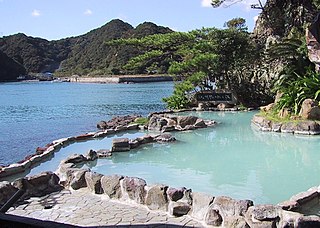
In Japan, onsen are the country's hot springs and the bathing facilities and traditional inns around them. As a volcanically active country, Japan has many onsens scattered throughout all of its major islands. There are approximately 25,000 hot spring sources throughout Japan that provide hot mineral water to about 3,000 genuine onsen establishments.

Sentō (銭湯) is a type of Japanese communal bathhouse where customers pay for entrance. Traditionally these bathhouses have been quite utilitarian, with a tall barrier separating the sexes within one large room, a minimum of lined-up faucets on both sides, and a single large bath for the already washed bathers to sit in among others. Since the second half of the 20th century, these communal bathhouses have been decreasing in numbers as more and more Japanese residences now have baths. Some Japanese find social importance in going to public baths, out of the theory that physical proximity/intimacy brings emotional intimacy, which is termed skinship in pseudo-English Japanese. Others go to a sentō because they live in a small housing facility without a private bath or to enjoy bathing in a spacious room and to relax in saunas or jet baths that often accompany new or renovated sentōs.

A ryokan is a type of traditional Japanese inn that typically features tatami-matted rooms, communal baths, and other public areas where visitors may wear yukata and talk with the owner. Ryokan have existed since the eighth century A.D. during the Keiun period, which is when the oldest hotel in the world, Nishiyama Onsen Keiunkan, was created in 705 A.D. Another old ryokan called Hōshi Ryokan was founded in 718 A.D. and was also known as the world's second oldest hotel. Such inns also served travelers along Japan's highways.
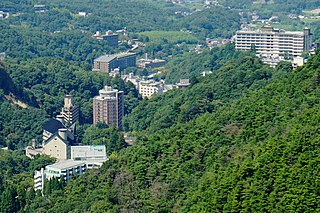
Arima Onsen is an onsen, or hot springs in Kita-ku, Kobe, Japan. This Onsen is still a hidden treasure of modern Kobe, behind Mount Rokkō. It attracts many Japanese who want tranquility with beautiful natural surroundings and yet easy access from the busy cities in the Kansai metropolitan area including Osaka. Arima Onsen was named in "The Pillow Book", a famous Heian Era book, as one of the three famous springs in Japan. It was selected as the most prestigious hot spring during the Edo Era.

Akayu was a town located in Higashiokitama District, Yamagata Prefecture, Japan.
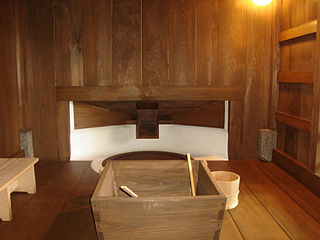
Furo, or the more common and polite form ofuro, is a Japanese bath and/or bathroom. Specifically it is a type of bath which originated as a short, steep-sided wooden bathtub. Baths of this type are found all over Japan in houses, apartments and traditional Japanese inns (ryokan) but are now usually made out of a plastic or stainless steel.

Kusatsu Onsen (草津温泉) is a hot spring resort located in Gunma Prefecture, Japan, northwest of Tokyo. It is a popular tourist destination.

The Nagaragawa Onsen are a group of onsen located along the banks of the Nagara River in Gifu, Gifu Prefecture, Japan. The source of the onsen are in the northern part of the city near the Mitabora Shinbutsu Onsen (三田洞神仏温泉). The group was included on the 16th edition of Japan's Top 100 Onsen.

Takayu Onsen (高湯温泉) is a hot spring resort in the Zainiwasaka district of the city of Fukushima, Fukushima, Japan. It is in the mountains about 14 km west of Fukushima Station.

Nishiyama Onsen Keiunkan (西山温泉慶雲館) is a hot spring hotel in Hayakawa, Yamanashi Prefecture, Japan. Founded in 705 AD by Fujiwara Mahito, it is a long-established business (shinise) as the oldest hotel and perhaps the oldest independent company in operation after Kongō Gumi was acquired in 2006. In 2011, the hotel was recognized by Guinness World Records as the oldest hotel in the world.

Beppu Onsen (別府温泉) is a group of hot springs in the city of Beppu, Ōita in Japan. Beppu Onsen is divided into eight major hot spring areas known as "Beppu Hatto".
Takahan Ryokan is a historic ryokan located in Yuzawa, Niigata Prefecture, Japan. The inn is over 800 years old. The inn has an onsen (bath) called "Tamago no Yu" that is supplied by natural hot springs with a slight amount of sulfur. The inn has approximately 20,000 annual visitors, many of whom visit to soak in Tamago no Yu.

Hoshino Resort Co., Ltd. is a Japan-based international operator of ryokan with its head office in Karuizawa, Nagano. Founded in 1904 by Kuniji Hoshino as a forestry business in Karuizawa, in the Japanese Alps, it opened its first hot spring resort in 1914.

Shima Onsen is a name of Japanese town and hot springs - onsen, the part of Nakanojō city in the Gunma Prefecture.
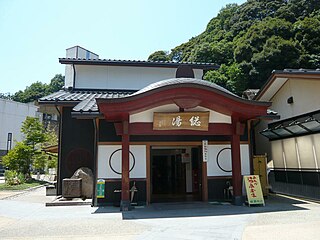
Awazu Onsen is a hot spring resort located in the city of Komatsu, Ishikawa Prefecture, Japan.

Unazuki Onsen is a hot spring resort located in the city of Kurobe, Toyama Prefecture, Japan, at the entrance of the Kurobe Gorge.

Tōgō Onsen (東郷温泉) is an onsen in the town of Yurihama in Tottori Prefecture, Japan. It was the second most popular onsen area in Tottori Prefecture during the beginning of the Shōwa era.
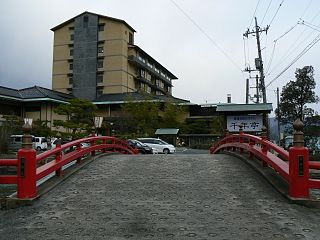
Hawai Onsen (はわい温泉) is an onsen in the town of Yurihama, Tōhaku District, in Japan's Tottori Prefecture. In recent years, it is the fourth most popular onsen in the prefecture, following Kaike Onsen, Misasa Onsen, and Yoshioka Onsen. It forms part of Misasa-Tōgōko Prefectural Natural Park, and some of the onsen district's lakeside area sits within Lake Tōgō Hawai Seaside Park.
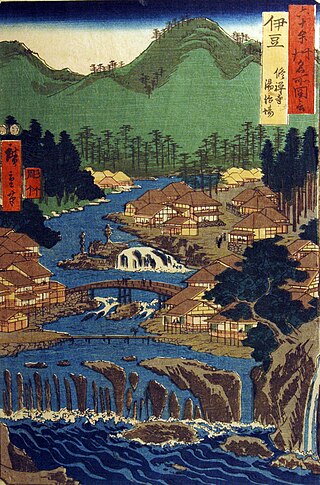
Shuzenji Onsen is a geothermal spring system in the Tagata District of Shizuoka Prefecture, Japan, in the central region of Izu Peninsula.

Yunomine Onsen is a hot spring system and resort town in Tanabe, near Hongu Town in southern Wakayama Prefecture, Japan. The Tsuboyu bath is located there, a UNESCO World Heritage site.
References
- ↑ "Itamuro Onsen Daikokuya" . Retrieved 25 February 2017.
- ↑ "Onsen, Art, Ryokan Daikokuya is established in 1551" . Retrieved 25 February 2017.
- ↑ "Daikokuya boasts 100% natural, free-flowing hot spring water" . Retrieved 25 February 2017.
- Article contains translated text from 板室温泉大黒屋 on the Japanese Wikipedia retrieved on 25 February 2017.